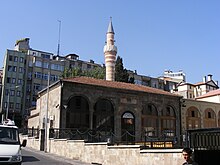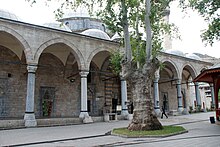Son cemaat yeri

Son cemaat yeri ( Turkish , about "meeting place for stragglers") is the Turkish name for a stone pedestal with a half-open vestibule ( portico ) in front of the prayer hall of a Friday mosque ( cami ), which is used for believers who have come too late for Friday prayers and on special holidays serves as a room to perform prayer ( ṣalāt ) and during the day as a place where the men talk.
The son cemaat yeri is a characteristic component of many of the great Ottoman mosques and is usually located together with the main entrance on the northern side opposite the qibla wall, which faces south in Turkey. Architecturally, it corresponds to the narthex, which is usually built in front of the west side of Byzantine churches . The latter is oriented with the direction of prayer on the apse and the altar in the east. Small mosques ( mescit ) have no vestibules. The most important mosques also include a rectangular inner courtyard ( avlu ) in front of the son cemaat yeri , which is usually surrounded on the other three sides by arcades or ancillary buildings and the center of which is a cleaning fountain ( şadırvan ) in the form of a pavilion.
The mosque vestibule consists of a stone platform that extends the entire length of the north wall on either side of the staircase and is covered by a series of semicircular domes. Walled arcade bays supported by columns form the support for the domes and characterize the entrance front of such mosques. Occasionally, during later renovations, the spaces between the columns were walled up to protect them from the weather or closed with glass panes. The stone floors can be laid out with carpets or covered with a board overlay.
A special feature is the son cemaat yeri of the Istanbul Ahi Çelebi Camii from the 17th century, which was donated by a doctor named Ahi Çelebi ibni Kemal at the beginning of the 16th century and has since been restored and rebuilt several times. In this mosque near the Galata Bridge , the portico is closed and looks narrow like a cave because it is adjusted by two massive pillars in the middle of the room. Together with the corresponding pilasters on the walls, these support six domes.
On Fridays or special Islamic holidays, the son cemaat yeri represents an additional room when the mosque no longer offers space for all those praying. A son cemaat yeri is generally accessible from the outside, so that the believers do not have to go through the prayer room before entering. According to this definition, it is disputed whether a room behind the north wall of the mosque of the Ishak Pasha Palace, which was started at the end of the 17th century in the far east of Turkey, should be called son cemaat yeri . It is only accessible via the mosque and, according to popular belief, served as an extended prayer room and at other times as a medrese .
Individual evidence
- ↑ Volker Eid : East Turkey. Peoples and cultures between Taurus and Ararat . DuMont, Cologne 1990, p. 109, ISBN 3-7701-1455-8
- ^ Thomas Alexander Sinclair: Eastern Turkey: An Architectural and Archaeological Survey. Vol. II. The Pindar Press, London 1989, p. 80
- ^ John Freely : A History of Ottoman Architecture. WIT-Press, Ashurst (Southampton) 2011, p. 24, ISBN 978-1845645069
- ^ John Freely, p. 212
- ↑ Yüksel Bingöl: The Ishak Pascha Palace in Doğubayazıt on Mount Ararat. A contribution to the building history of a Turkish palace in the 18th century . (Writings on literature, art and social history Volume 2) Edition Orient, Berlin 1982, ISBN 3-922825-08-7 , p. 68.
